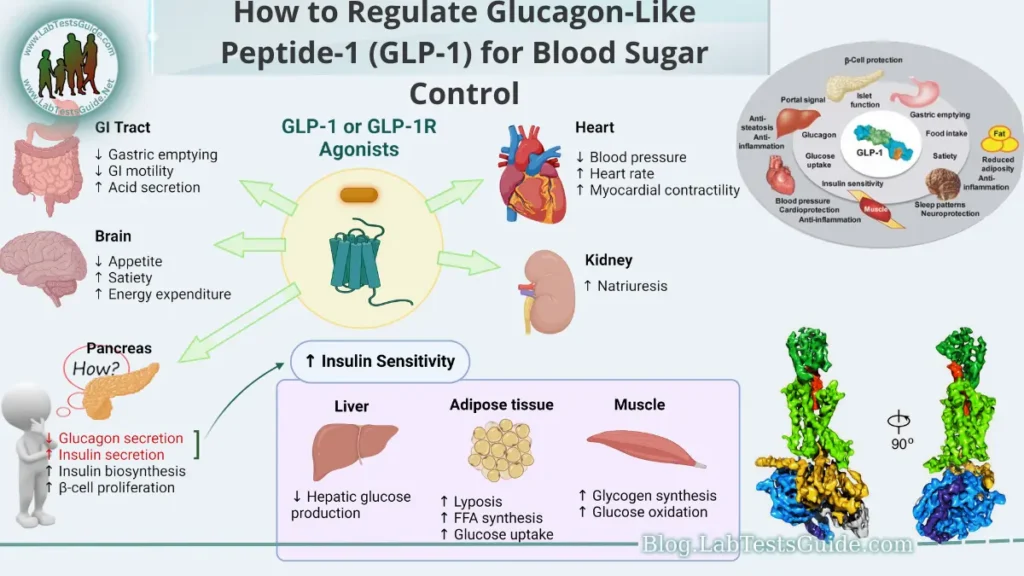Glucagon-like peptide-1 (GLP-1) is a hormone that plays a crucial role in regulating blood sugar levels. It is primarily secreted by the cells in the intestine in response to food intake. GLP-1 acts on various organs and tissues, including the pancreas, liver, and brain, to stimulate insulin secretion, suppress glucagon release, slow down gastric emptying, and promote satiety.

The regulation of GLP-1 is of paramount importance for individuals with conditions such as type 2 diabetes, as impaired GLP-1 signaling can lead to inadequate insulin secretion and difficulty in blood sugar control. Therefore, understanding how to regulate GLP-1 levels effectively becomes essential in managing blood glucose levels and improving overall glycemic control.
What is Importance of Regulating GLP-1 for Blood Sugar Control?
Here are some key reasons why GLP-1 regulation is significant.
- Insulin Secretion: GLP-1 stimulates the release of insulin from pancreatic beta cells in response to elevated blood sugar levels. Insulin helps transport glucose from the bloodstream into cells, reducing blood sugar levels. By enhancing GLP-1 activity, the secretion of insulin can be increased, promoting better glucose control.
- Glucagon Suppression: GLP-1 inhibits the release of glucagon, a hormone that raises blood sugar levels by stimulating the liver to release stored glucose. By reducing glucagon secretion, GLP-1 helps prevent excessive glucose production and maintains a balanced glucose environment.
- Slowing Gastric Emptying: GLP-1 slows down the rate at which the stomach empties its contents into the small intestine. This delay in gastric emptying helps regulate the absorption of glucose from the intestines, preventing sudden spikes in blood sugar levels after meals.
- Appetite and Satiety Regulation: GLP-1 plays a role in appetite control by promoting feelings of fullness and satiety. By regulating GLP-1 levels, individuals may experience reduced food intake, leading to weight loss or weight maintenance. This is particularly beneficial for individuals with type 2 diabetes who may struggle with obesity or weight management.
- Beta Cell Function and Survival: GLP-1 has been shown to have a positive impact on the function and survival of pancreatic beta cells. By promoting their health and preventing their decline, GLP-1 regulation can help preserve insulin production capacity over time.
How to Natural Regulation of GLP-1?
Here are the key aspects of natural GLP-1 regulation.
- GLP-1 Production and Secretion: GLP-1 is produced by specialized cells called L-cells located in the lining of the small intestine, particularly the ileum and colon. The production and secretion of GLP-1 are primarily stimulated by the presence of nutrients in the intestine, especially carbohydrates and fats. When food enters the digestive system, L-cells sense the nutrients and release GLP-1 into the bloodstream.
- GLP-1 Half-Life and Degradation: GLP-1 has a short half-life of only a few minutes as it is rapidly degraded by an enzyme called dipeptidyl peptidase-4 (DPP-4). DPP-4 breaks down GLP-1 into inactive fragments, limiting its activity and duration of action. This rapid degradation is one of the reasons why GLP-1-based therapies often involve the use of medications that inhibit DPP-4 activity.
- GLP-1 Receptor Activation: Once released into the bloodstream, GLP-1 binds to specific receptors called GLP-1 receptors located on various target tissues, including pancreatic beta cells, liver cells, and neurons in the brain. Binding to these receptors initiates a series of signaling events that regulate insulin secretion, glucagon suppression, gastric emptying, and appetite control.
GLP-1 Receptor Agonists:
Here are some key points about GLP-1 receptor agonists.
- Mechanism of Action: GLP-1 receptor agonists work by activating GLP-1 receptors on various target tissues. This activation stimulates insulin secretion from pancreatic beta cells, inhibits glucagon release from the pancreas, slows down gastric emptying, and promotes satiety. These combined effects help lower blood sugar levels, reduce postprandial glucose spikes, and contribute to weight loss.
- Clinical Uses and Benefits: GLP-1 receptor agonists are primarily used in the treatment of type 2 diabetes. They can be prescribed as monotherapy or in combination with other antidiabetic medications, such as metformin or insulin. GLP-1 receptor agonists have been shown to effectively lower blood sugar levels, improve glycemic control, and reduce the risk of cardiovascular events. They are also associated with weight loss and may have beneficial effects on blood pressure and lipid profiles.
Commonly Prescribed GLP-1 Receptor Agonists:
There are several GLP-1 receptor agonists available on the market. Some commonly prescribed ones include.
- Exenatide (Byetta, Bydureon)
- Liraglutide (Victoza)
- Dulaglutide (Trulicity)
- Semaglutide (Ozempic)
- Albiglutide (Tanzeum)
These medications differ in terms of their dosing frequency (daily or weekly), route of administration (injection), and specific clinical indications. They have varying degrees of efficacy and side effect profiles, so the choice of GLP-1 receptor agonist depends on individual patient factors and preferences.
Dipeptidyl Peptidase-4 (DPP-4) Inhibitors:
Here are some important points about DPP-4 inhibitors.
Mechanism of Action: DPP-4 inhibitors block the activity of the enzyme DPP-4, which normally breaks down GLP-1 into inactive fragments. By inhibiting DPP-4, these medications increase the levels of endogenous GLP-1, allowing it to exert its effects for a longer duration.
Clinical Uses and Benefits: DPP-4 inhibitors are primarily used as oral antidiabetic agents for the treatment of type 2 diabetes. They are often prescribed as monotherapy or in combination with other medications, such as metformin or sulfonylureas. DPP-4 inhibitors help lower blood sugar levels by enhancing GLP-1 activity, stimulating insulin secretion, suppressing glucagon release, and slowing gastric emptying. They are generally well-tolerated and do not cause weight gain.
Commonly Prescribed DPP-4 Inhibitors:
There are several DPP-4 inhibitors available on the market. Some commonly prescribed ones include.
- Sitagliptin (Januvia)
- Saxagliptin (Onglyza)
- Linagliptin (Tradjenta)
- Alogliptin (Nesina)
These medications are taken orally, usually once daily, and have similar mechanisms of action. However, they may differ in terms of dosing, potential drug interactions, and specific considerations. The choice of DPP-4 inhibitor depends on factors such as individual patient needs, tolerability, and cost.
- Considerations and Precautions: DPP-4 inhibitors are generally well-tolerated, but they may have side effects such as nasopharyngitis, upper respiratory tract infections, headache, and gastrointestinal symptoms. They are generally considered safe for use, but caution is advised in individuals with a history of pancreatitis. It is important to monitor renal function in patients taking DPP-4 inhibitors, as dose adjustments may be required for those with impaired kidney function.
Other Approaches to Regulate GLP-1:
Here are some key points about these alternative methods.
Nutritional and Lifestyle Interventions:
- Diet: Certain dietary choices can influence GLP-1 levels. Consuming a diet rich in fiber, such as whole grains, legumes, fruits, and vegetables, may promote GLP-1 secretion. Additionally, reducing the intake of processed foods, sugary beverages, and high-fat meals may help optimize GLP-1 function.
- Meal Timing: Studies suggest that spacing out meals and incorporating regular fasting periods, such as intermittent fasting, can enhance GLP-1 response and improve blood sugar control.
- Exercise: Regular physical activity has been shown to increase GLP-1 secretion. Engaging in aerobic exercises, resistance training, or a combination of both can contribute to better GLP-1 regulation and overall metabolic health.
Surgical Options:
- Bariatric Surgery: Procedures like gastric bypass or sleeve gastrectomy, performed primarily for weight loss in individuals with obesity, have been found to significantly increase GLP-1 secretion. This increase in GLP-1 levels contributes to improved insulin sensitivity and blood sugar control.
Future Developments and Research:
- Ongoing research aims to explore novel therapeutic strategies for GLP-1 regulation. This includes the development of new medications with improved pharmacokinetics and longer half-lives, as well as novel drug delivery systems such as oral GLP-1 formulations.
- Researchers are also investigating the potential of GLP-1-based therapies in the treatment of conditions beyond diabetes, such as obesity, cardiovascular disease, and neurodegenerative disorders.
Considerations and Precautions:
Here are some key points to consider.
- Side Effects and Adverse Reactions: GLP-1 receptor agonists and DPP-4 inhibitors, like any medications, can have potential side effects. Common side effects may include nausea, vomiting, diarrhea, and abdominal discomfort. It’s important to be aware of these potential side effects and discuss any concerns with your healthcare provider. In rare cases, severe allergic reactions or pancreatitis may occur, so it’s crucial to seek immediate medical attention if any unusual symptoms arise.
- Drug Interactions: It is essential to inform your healthcare provider about all the medications, supplements, and herbal products you are taking. Some medications, such as certain antibiotics or antifungal agents, may interact with GLP-1-based therapies and affect their effectiveness or increase the risk of side effects. Your healthcare provider can assess potential drug interactions and adjust medication regimens accordingly.
- Patient Monitoring and Follow-up: Regular monitoring of blood sugar levels, as well as other relevant parameters such as weight, blood pressure, and kidney function, is necessary to evaluate treatment effectiveness and ensure patient safety. Your healthcare provider may recommend periodic laboratory tests and follow-up appointments to assess treatment response and make any necessary adjustments.
- Individualized Treatment Plans: GLP-1 regulation approaches should be tailored to individual needs and medical conditions. Factors such as age, kidney function, liver function, pregnancy status, and concomitant medications need to be taken into account when determining the most suitable GLP-1-based therapy or intervention.
- Adherence and Lifestyle Modifications: Alongside medication or interventions, adherence to prescribed treatment plans and lifestyle modifications is crucial for successful blood sugar control. This may include dietary changes, regular physical activity, weight management, and proper medication administration. Working closely with your healthcare provider and diabetes care team can help optimize treatment outcomes.
FAQs:
Can I regulate GLP-1 naturally through diet and lifestyle alone?
While diet and lifestyle modifications can have a positive impact on GLP-1 regulation, they may not be sufficient for everyone, especially in individuals with type 2 diabetes. GLP-1-based medications or interventions may be necessary to achieve optimal blood sugar control in such cases.
Are GLP-1 receptor agonists and DPP-4 inhibitors the same thing?
No, GLP-1 receptor agonists and DPP-4 inhibitors are different classes of medications. GLP-1 receptor agonists directly activate GLP-1 receptors, while DPP-4 inhibitors block the enzyme that degrades GLP-1, thus increasing its levels. Both approaches enhance GLP-1 activity, but they have distinct mechanisms of action.
How long do GLP-1 receptor agonists and DPP-4 inhibitors remain active in the body?
GLP-1 receptor agonists have varying durations of action depending on the specific medication. Some require daily injections, while others have a longer half-life and can be administered weekly. DPP-4 inhibitors are typically taken orally once daily.
Can GLP-1-based therapies cause weight loss?
Yes, GLP-1 receptor agonists and DPP-4 inhibitors are associated with weight loss in many individuals. These medications can decrease appetite and promote feelings of fullness, leading to reduced food intake and subsequent weight loss.
Are GLP-1-based therapies suitable for everyone with type 2 diabetes?
GLP-1-based therapies can be effective for many individuals with type 2 diabetes, but they may not be appropriate for everyone. Factors such as medical history, individual response, and other medications being taken should be considered when determining the suitability of these therapies. It is important to consult with a healthcare provider for personalized recommendations.
Are there any potential risks or side effects associated with GLP-1-based therapies?
GLP-1-based therapies may have side effects such as nausea, vomiting, diarrhea, and abdominal discomfort. In rare cases, severe allergic reactions or pancreatitis can occur. It is important to discuss potential risks and side effects with your healthcare provider and promptly report any unusual symptoms.
Can GLP-1 regulation be used in conditions other than diabetes?
GLP-1-based therapies are primarily used in the management of type 2 diabetes. However, ongoing research is exploring their potential applications in other conditions such as obesity, cardiovascular disease, and neurodegenerative disorders. The use of GLP-1-based therapies in these conditions is still being investigated and may require further evidence and approval.
Conclusion:
In conclusion, the regulation of glucagon-like peptide-1 (GLP-1) is of paramount importance for blood sugar control, particularly in individuals with conditions like type 2 diabetes. Approaches such as GLP-1 receptor agonists and dipeptidyl peptidase-4 (DPP-4) inhibitors offer effective pharmacological interventions to enhance GLP-1 activity. Additionally, nutritional and lifestyle interventions, as well as surgical options, can contribute to GLP-1 regulation. Considerations such as side effects, drug interactions, individualized treatment plans, and adherence to lifestyle modifications are crucial. With advancements in research, GLP-1-based therapies hold promise for improving glycemic control and overall health outcomes in individuals managing blood sugar levels. Close collaboration with healthcare professionals is essential to optimize treatment strategies and achieve personalized blood sugar control goals.






